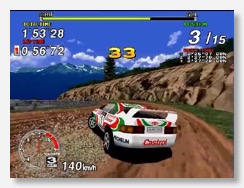16 - Sega Rally Championship

Sega Rally Championship changed everything for the racing genre, and the 1995 off-road arcade hit was an incredible game too. This is the story of its development, critical reception, and long-term legacy.
If you're keen to grab one of the Sega Rally games on Amazon, please use my affiliate link so that I get a small portion of the sale price.
(Partial) Transcript
Virtual motorsport didn’t often drift over to the roads less travelled, back before Sega research and development division AM3 turned its attention to rally cars in the mid-90s. The genre had done Formula One and motorcycle racing again and again, going back almost to the beginning of video games, and it had done loads of sports car racing — even of the illegal street racing variety. But off-road was a rarity, and this was apparently not from neglect.
In Japan, AM3’s senior staff once told Edge Magazine, rally games were considered taboo. They lacked the excitement that virtual racing needed, the reasoning went — especially for a busy, noisy arcade.
At least until AM3 went and changed everything.
That fact that Sega Rally Championship would come to stand out, to set new benchmarks and forever alter the racing genre — it wasn’t something that happened by accident. Development began in the shadow of hit games Daytona USA, which had been developed by sister studio Sega AM2, and Namco’s Ridge Racer, both cutting-edge arcade racers at the time, with a fast-growing reputation as two of the greatest racing games ever made.
AM3 wanted to take these and then put a new spin on them — to outdo them, to outshine and outmanoeuvre and outrace them with an even cooler competitive racing game. Rally racing, that oft-neglected branch of high-octane vehicular action, seemed like it had the right ingredients.
But in order to give arcade gamers the sense that they were really sliding their car sideways around a muddy bend at 150 kilometres an hour, AM3 had a big task ahead of them. Daytona was about raw speed — just barrelling down the straights and then hitting the corners hard without crashing into any other cars. And Ridge Racer was about style — about drifting around the bends almost like you were floating on them.
But Sega Rally needed to have more of a grit to it, because that’s what rallying is all about — you’ve got loose gravel, mud, and dirt shooting up around you as you wrestle with the steering wheel even to keep the car on a straight road. And you’re desperate to stay on that road because if you go more than a few inches off the edge, you’re liable to find yourself wrapped around a tree or stuck in a ditch or — if you really mess things up — maybe flying off the side of a mountain.
The AM3 team didn’t get off to the best start, either. None of them had ever driven a rally car before, so they asked two of the most experienced rally car manufacturers, Toyota and Lancia, for help with getting it right. Both companies said no, even though they’d given the all-clear for their cars to be reproduced in-game.
(For more you'll have to either just listen to the episode or sign up as a supporter on Patreon — everyone who pledges $3 or more a month gets access to full episode transcripts [amongst other things].)
The Life & Times of Video Games on the Web and social media
- Website: lifeandtimes.games
- Twitter: @LifeandTimesVG
- Instagram: @lifeandtimesvg
- YouTube: lifeandtimes.games/youtube
You can make a donation to help cover running costs and allow me to rely less on freelance income via
- Patreon: lifeandtimes.games/patreon
- or PayPal: paypal.me/mossrc
My book, The Secret History of Mac Gaming, is available in bookstores in the UK and Australia, as well as online from the likes of Book Depository and Amazon. See the official website for more info.
Can't afford to give me money? Consider listening via the RadioPublic app for Android or iOS. It's free. And if you enable analytics then I get paid a couple of cents each time you listen to my show. Head to RadioPublic.com for more info.


